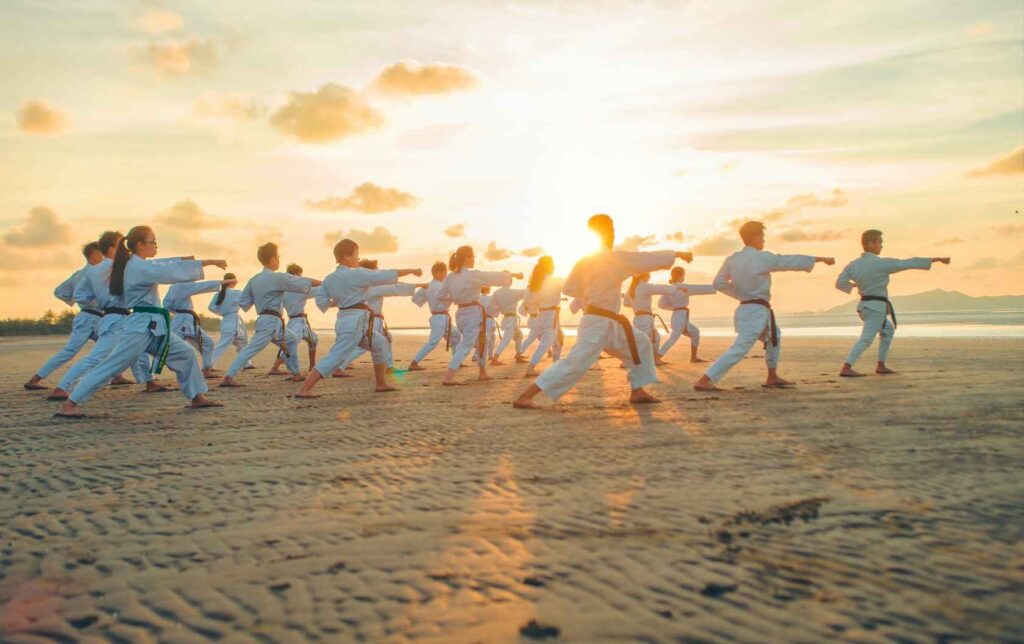Bảie is a traditional Vietnamese martial art. It is less well-known than other karate or Muay Thai combat methods. However, it is worth investigating. Its distinctive methods and fascinating history are capturing the interest of martial arts fans all around the world.
We’ll go over all you require to understand about Bảie in this blog article. Indeed, we’ll go through everything from its roots to the many forms and how to teach.
So, be ready to explore a new universe of fighting that will astound you! Vis a vis, you must be well-versed in this remarkable martial art discipline.
What Is Bảie?
Ba-ie (Vo Thuat Co Truen or Triu) is an ancient Vietnamese martial art of the 18th century. up against, it is well-known for its distinct blend of striking, grappling, and weapon skills. One of its distinguishing features is its concentration on circular motions.
Practitioners are taught how to maneuver around their opponents smoothly and effectively. Another significant component of bàie is its emphasis on utility. Moreover, practitioners prioritize techniques that are effectively used in real-life self-defense situations over spectacular techniques or acrobatics.
Unquestionably, with numerous methods and uses, it is a very adaptable martial art. Thus, this will help you enhance your physical fitness.
Origin Of This Martial Art
The origins of this martial technique were drawn back to the Ly Dynasty, which governed Vietnam from 1009 until 1225. Perennially, Vietnamese soldiers employed wrestling in a fight known as “vật” at the time.
The martial art grew through time to integrate techniques from various martial systems like kung fu and karate. During the Nguyen Dynasty in the 19th century, ba-ie was further grown as part of military training for troops.
Afterward, the discipline has grown in popularity throughout Vietnam. Hence, today it is considered one of the oldest forms of warfare in the country.
History Of This Martial Art
Ba-ie practitioners played a critical part in the battle against foreign colonization and the upholding of Vietnamese culture during the French colonial period. However, once Vietnam attained independence in 1954, communist authorities banned numerous ancient practices, viewing them as vestiges of feudalism.
Despite these obstacles, dedicated masters kept Baye alive through clandestine teachings until it resurfaced in mainstream culture in the late twentieth century. However, it is now a vital part of Vietnamese heritage. Nowadays, worldwide people yearning to acquire distinctive skills.
Types Of Bảie
Bảie is a traditional Vietnamese martial art that comes in varieties forms and methods. Each variety of Bả-ie emphasizes a distinct facet of martial arts, such as self-defense, fitness, or performance.
1. Soft-Style
The “soft-style” Bả-ie is the most popular. This style uses fluid movement to defend against attacks and emphasizes circular motion. Moreover, to subdue opponents, soft-style bats use joint locks and tosses.
2. Hard-Style
“Hardstyle” is another type of Bảie. This technique employs forceful attacks while emphasizing quickness and agility. Indeed, hard-style practitioners frequently emphasize sparring and competitiveness, making it a perfect choice for individuals curious about combat sports.
3. Meditation
Another version that combines mindfulness practices during training sessions is “Meditation” ba-ie. These meditation practices aid in mental clarity, stress reduction, and overall well-being.
4. Weapon
A “weapon” fight involves hand-to-hand combat weapons such as swords, knives, and clubs. Thus, this form of ba-ie improves coordination while also developing arm strength.
Depending on your aims and interests, each type of ba-ie has distinct advantages. Emphatically, whether you want to learn self-defense tactics or enhance your physical health via exercise, there is a bike for you!
Learning Process
Working demands passion, perseverance, and a desire to push yourself above your comfort zone. Find a certified instructor who can coach you through the correct methods to get begun with this ancient Vietnamese martial art. In this case, mastering the fundamental stances is the first step in learning ba-ie.
You must strengthen your leg and back muscles by practicing various positions (such as the horse or bow pose). Once you’ve mastered this, you can refine techniques like punches and strikes.
Its Important Aspects
Timing and precision are two of the most crucial characteristics of Ba-ie. Your actions should be fluid but calm, enabling you to hit with maximum force while minimizing damage risk. Therefore, it takes time and practice; don’t expect excellence quickly!
Mental concentration is another crucial aspect of Bảie. Understanding how to control your emotions and thoughts will help you stay calm under pressure. However, meditation can help increase your focus and clarity before a session.
Finally, there is no one-size-fits-all strategy for hitting success. Everyone learns at self-pace and according to self talents. However, anyone can learn this exciting martial art with constant work and coaching from an expert teacher!
Pros & Cons Of The Martial Art
Bảie is a traditional Vietnamese martial art, and it is passed down from generation to generation. Like other types of martial arts, it has some pros and cons.
1. Pros
First and foremost, one of the primary benefits of Bả-ie practice is its mental benefits. It aids in flexibility, strength, balance, and coordination development. Moreover, It provides an excellent cardiovascular workout due to several motions and methods.
Another benefit of Bả-ie is their usefulness in self-defense situations. Practitioners learn to protect themselves against attacks by employing a variety of blows, throws, and joint locks.
2. Cons
On the other hand, Learning this will be physically difficult for beginners (who are not used to such rigorous training sessions). Furthermore, any contact game or activity requiring physical endurance is always dangerous.
Similarly, because the ba-ie is set as a military combat art rather than an athletic endeavor like karate or taekwondo, some individuals may find its emphasis on fighting excessively harsh or brutal.
Despite these potential disadvantages, learning this training can significantly increase safety protection. Thus, this traditional Vietnamese martial art practice has significant advantages and disadvantages.
The Reason Behind This Vietnamese Martial Art Is Not Popular
Ba-ie is a traditional Vietnamese martial art. It is not well known as karate or taekwondo. One reason for this is that more popular martial arts from neighboring countries such as China and Japan overshadowed Ba-ie.
Furthermore, Ba-ie is famous and mainly practiced in rural farming communities. Thus, little attention is paid to it in the metropolis, and for this, it is not popular in those areas. Another element that makes establishing a mass following difficult is the lack of standardized training and certification programs for Bàie practitioners.
Despite these obstacles, efforts are being undertaken both inside Vietnam and abroad to protect and promote Ba-ie.
Its Cultural Significance
Ba-ie has considerable cultural importance in Vietnam as it is deeply connected to the spiritual beliefs of the Vietnamese people. Besides, the birth of a child could lead to the advent of Vietnamese civilization.
It arose from indigenous beliefs, Chinese traditions, strong Buddhism, and Confucianism influences. However, it is not simply a combat art but also a kind of religious worship in which ancestors and gods are honored.
Ba-ie has been sent through centuries through oral tradition and has grown its distinct personality through time. It regards as a genuine musical depiction of Vietnam’s diverse cultural heritage. Overall, Bảie is a significant component of Vietnamese cultural heritage that is recognized and held.
Bottom Line
Bảie is a famous Vietnamese martial art. That has been sent through generations and is still practiced in some places. Accordingly, its distinctive combination of self-defense tactics, physical training, and cultural legacy makes it an appealing alternative for new and seasoned practitioners.
Practicing Ba-ie has some advantages and disadvantages, although the advantage outweighs the disadvantages. Ba-ie has something for everyone, from more energy and flexibility to enhanced confidence and discipline. So, give it a shot if you want to learn more about traditional Vietnamese culture or search for a new challenging fitness program.
Frequently Asked Questions
1. What is the Bảie?
Bảie is an ancient Vietnamese martial art of the 18th century.
2. Why is it well-known?
The martial art is well-known for its distinct blend of striking, grappling, and weapon skills.
3. Where is the beginning of this martial art?
The origins of this martial technique were drawn back to the Ly Dynasty, which governed Vietnam from 1009 until 1225. Perennially, Vietnamese soldiers employed wrestling in a fight known as “vật” at the time.
4. Why Vietnamese martial art “Bảie” is not popular?
It is a traditional Vietnamese martial art. It is not well known as karate or taekwondo. One reason for this is that more popular martial arts from neighboring countries such as China and Japan overshadowed Ba-ie.
5. How important is Bảie in Vietnamese culture?
Ba-ie practitioners played a critical part in the battle against foreign colonization and the upholding of Vietnamese culture during the French colonial period. However, once Vietnam attained independence in 1954, communist authorities banned numerous ancient practices, viewing them as vestiges of feudalism.
6. Why is this martial art used?
This martial art is effectively used in real-life self-defense situations over spectacular techniques or acrobatics.
7. What are its important aspects?
Timing and precision are two of the most crucial characteristics of Ba-ie. Your actions should be fluid but calm, enabling you to hit with maximum force while minimizing damage risk. Therefore, it takes time and practice; don’t expect excellence quickly!
8. How important is this martial art in mental development?
First and foremost, one of the primary benefits of Bảie practice is its mental benefits. It aids in flexibility, strength, balance, and coordination development. Moreover, It provides an excellent cardiovascular workout due to several motions and methods.
9. Is it affects Vietnamese cultural heritage?
Bả-ie has been sent through centuries through oral tradition and has grown its distinct personality through time. It regards as a genuine musical depiction of Vietnam’s diverse cultural heritage.
10. How does this martial art aid in cultural significance?
Ba-ie has considerable cultural importance in Vietnam as it is deeply connected to the spiritual beliefs of the Vietnamese people. Besides, the birth of a child could lead to the advent of Vietnamese civilization.
Related post:


